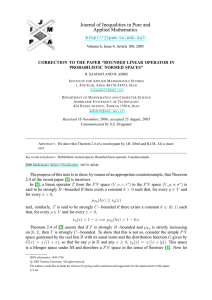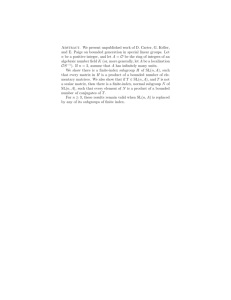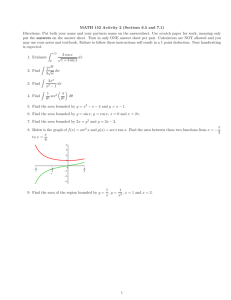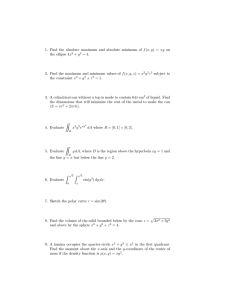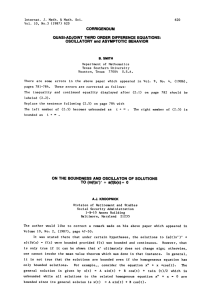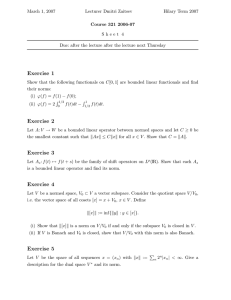J I P A
advertisement
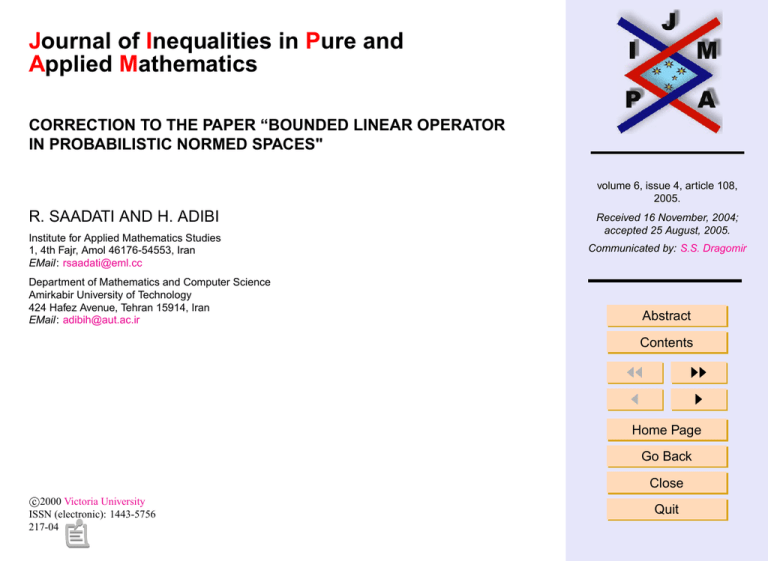
Journal of Inequalities in Pure and Applied Mathematics CORRECTION TO THE PAPER “BOUNDED LINEAR OPERATOR IN PROBABILISTIC NORMED SPACES" volume 6, issue 4, article 108, 2005. R. SAADATI AND H. ADIBI Institute for Applied Mathematics Studies 1, 4th Fajr, Amol 46176-54553, Iran EMail: rsaadati@eml.cc Department of Mathematics and Computer Science Amirkabir University of Technology 424 Hafez Avenue, Tehran 15914, Iran EMail: adibih@aut.ac.ir Received 16 November, 2004; accepted 25 August, 2005. Communicated by: S.S. Dragomir Abstract Contents JJ J II I Home Page Go Back Close c 2000 Victoria University ISSN (electronic): 1443-5756 217-04 Quit Abstract We show that Theorem 2.4 of a recent paper by I.H. Jebril and R.I.M. Ali is incorrect. 2000 Mathematics Subject Classification: 54E70, 46S40 Key words: Probabilistic normed spaces; Bounded linear operator; Counterexample. The authors would like to thank the referees for giving useful comments and suggestions for the improvement of this paper. Correction to the paper “Bounded Linear Operator in Probabilistic Normed Spaces" R. Saadati and H. Adibi The purpose of this note is to show, by means of an appropriate counterexample, that Theorem 2.4 of the recent paper [2] is incorrect. In [2], a linear operator T from the P N space (V, ν, τ, τ ∗ ) to the P N space (V, µ, σ, σ ∗ ) is said to be strongly B−bounded if there exists a constant h > 0 such that, for every p ∈ V and for every x > 0, µT p (hx) ≥ νp (x) and, similarly, T is said to be strongly C−bounded if there exists a constant h ∈ (0, 1) such that, for every p ∈ V and for every x > 0, νp (x) > 1 − x =⇒ µT p (hx) > 1 − hx. Theorem 2.4 of [2] asserts that if T is strongly B−bounded and µT p is strictly increasing on [0, 1], then T is strongly C−bounded. To show that this is not so, Title Page Contents JJ J II I Go Back Close Quit Page 2 of 4 J. Ineq. Pure and Appl. Math. 6(4) Art. 108, 2005 http://jipam.vu.edu.au consider the simple P N space generated by the real line R with its usual norm and the distribution function G given by G(x) = x/(1 + x), so that for any p in R and any x ≥ 0, νp (x) = x/(x + |p|). This space is a Menger space under M and therefore a P N space in the sense of Šerstnev [1]. Now let T : R → R be the linear map defined by T p = 2p and note that ν2p is strictly increasing on [0, 1]. Then if h > 2, νT p (hx) = hx hx ≥ = νp (x), hx + 2|p| hx + h|p| whence T is strongly B−bounded. (Note that this holds in any simple P N space.) But for x = 1/2 and p = 1/4, we have νp (x) = 2/3 > 1/2 = 1 − x, whereas, for any h in (0, 1), ν2p (hx) = h/(1 + h) < 1 − h/2 = 1 − hx, so that T is not strongly C−bounded. Correction to the paper “Bounded Linear Operator in Probabilistic Normed Spaces" R. Saadati and H. Adibi Title Page Contents JJ J II I Go Back Close Quit Page 3 of 4 J. Ineq. Pure and Appl. Math. 6(4) Art. 108, 2005 http://jipam.vu.edu.au References [1] C. ALSINA, B. SCHWEIZER AND A. SKLAR, On the definition of a probabilistic normed space, Aequationes Math., 46 (1993) 91–98. [2] I.H. JEBRIL AND R.M. ALI, Bounded linear operator in probabilistic normed spaces, J. Inequal. Pure Appl. Math., 4(1) (2003), Art. 8. [ONLINE: http://jipam.vu.edu.au/article.php?sid=244] Correction to the paper “Bounded Linear Operator in Probabilistic Normed Spaces" R. Saadati and H. Adibi Title Page Contents JJ J II I Go Back Close Quit Page 4 of 4 J. Ineq. Pure and Appl. Math. 6(4) Art. 108, 2005 http://jipam.vu.edu.au
